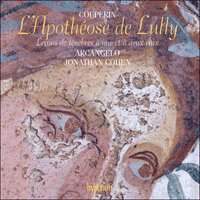Texte paru dans: / Appeared in: |
|
|
Outil de traduction ~ (Très approximatif) |
|
|
Reviewer: Charles
Brewer
Since these two works
represent very different genres, this review will be in two parts.
Part I: François Couperin was
well aware of both the roots of the French style in the works of Jean-Baptiste
Lully and his own appreciation for the newer styles of Italian music. In his
two Apotheoses for Corelli (1724) and Lully (1725) he sought to render
musical homage to his two musical models. These two works also
Part II: Though Couperin was
not a prolific composer of church music (like, for example, Marc-Antoine
Charpentier or Michael-Richard de Lalande), he did write a number of
smallerscale compositions, a few of which were meant for his cousin,
Marguerite-Louise Couperin (1675-1728), who, though a woman, had royal
dispensation to sing sacred works for the court. The best known and most
often recorded are the Tenebrae Readings for Holy Wednesday, written in 1714
for the Holy Week liturgy at the Abbaye Royale de Longchamp, a fashionable
convent that would hire singers from the Paris Opera but also charge for a
seat in the church. Since the readings from the Lamentations of Jeremiah
were distributed among the Matins offices for Maundy Thursday, Good Friday,
and Holy Saturday, but usually in the middle of the night, French tradition
moved them to the previous afternoons; hence Couperin’s reference to
Wednesday for the Maundy Thursday readings, from Lamentations 1:1-14.
Couperin divided his text into the traditional three lessons and composed
the first and second lessons for a single soprano and the third for two
sopranos. Often, as in this new release, two singers alternate in the first
two lessons and combine for the third. A few recordings have been made with
countertenors (May/June 1992, July/Aug 1995 see TALLIS, and Mar/Apr 2006).
On this new release, Katherine
Watson sings the first and Anna Dennis, with a slightly darker timbre, the
second; when combined in the third lesson, they are well matched but are
subtly different in timbre, which is very evident where the voices cross
over each other. Both have clear and flexible voices, and both manage the
intricate trills and turns of French ornamentation with ease. The continuo,
played by Jonathan Cohen (organ), Thomas Dunford (lute), and Anne-Marie
Lasla (viola da gamba), is supportive and unobtrusive. This is a very
stylish performance, using French Latin pronunciation, and every bit as good
as the recording led by William Christie (Sept/Oct 1997), also with French
Latin but harpsichord for continuo. Some earlier recordings use traditional
ecclesiastical Latin, such as the ones by Christophe Rousset (July/Aug
2000), though that means ignoring a few of Couperin’s explicit articulation
markings. A favorite of mine was by Laurence Bouley (Musifrance 45012).
So, in conclusion, “A
chacun son goût.” | |
|
Support us financially by purchasing this disc from eiher one of these
suppliers. Un achat via l'un ou l'autre des fournisseurs proposés contribue à défrayer les coûts d'exploitation |
|
|
|
|
|
Cliquez l'un ou l'autre
bouton pour découvrir bien d'autres critiques de CD |
|




